Abstract
Antibody-based therapies for cancer rely on the expression of defined antigens on neoplastic cells. However, most tumors display heterogeneity in the expression of such antigens. We demonstrate here that antibody-targeted interleukin 2 delivery overcomes this problem by induction of a host immune response. Immunohistochemical analysis demonstrated that the antibody-interleukin 2 fusion protein-induced eradication of established tumors is mediated by host immune cells, particularly CD8+ T cells. Because of this cellular immune response, antibody-directed interleukin 2 therapy is capable to address established metastases displaying substantial heterogeneity in expression of the targeted antigen. This effector mechanism further enables the induction of partial regressions of large subcutaneous tumors that exceeded more than 5% of the body weight. These observations indicate that antibody-directed cytokine delivery offers an effective new tool for cancer therapy.
Full text
PDF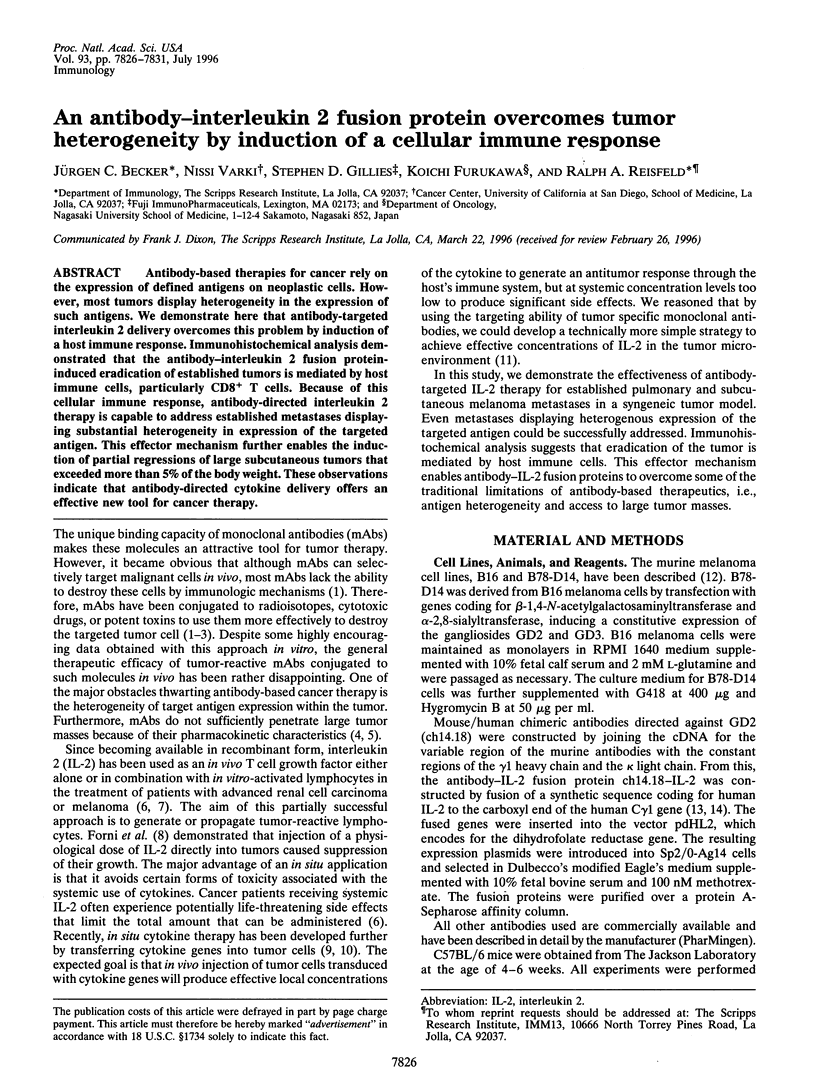
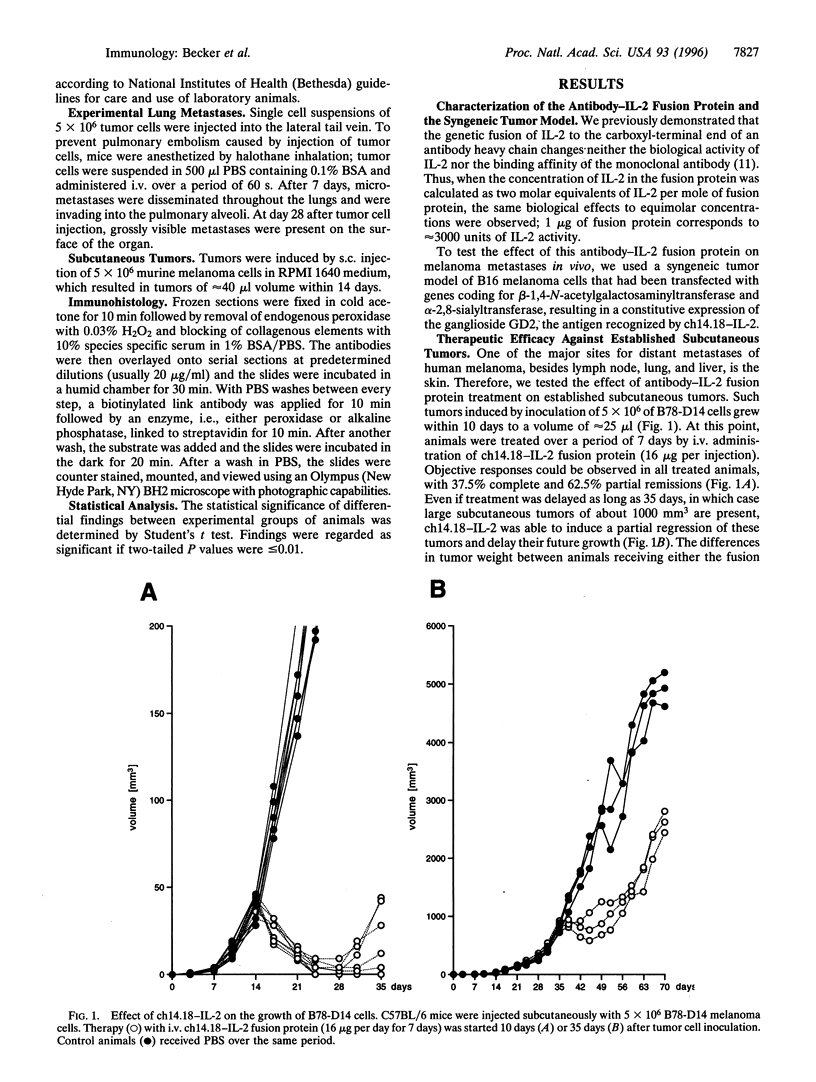
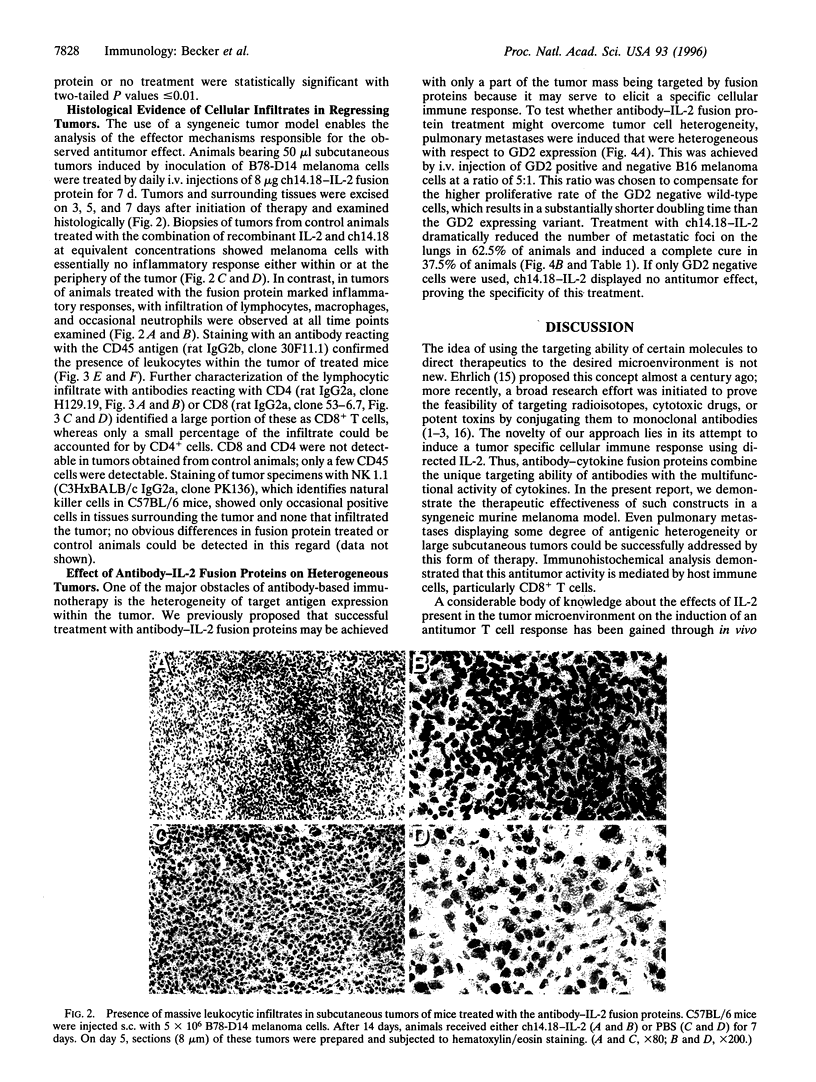
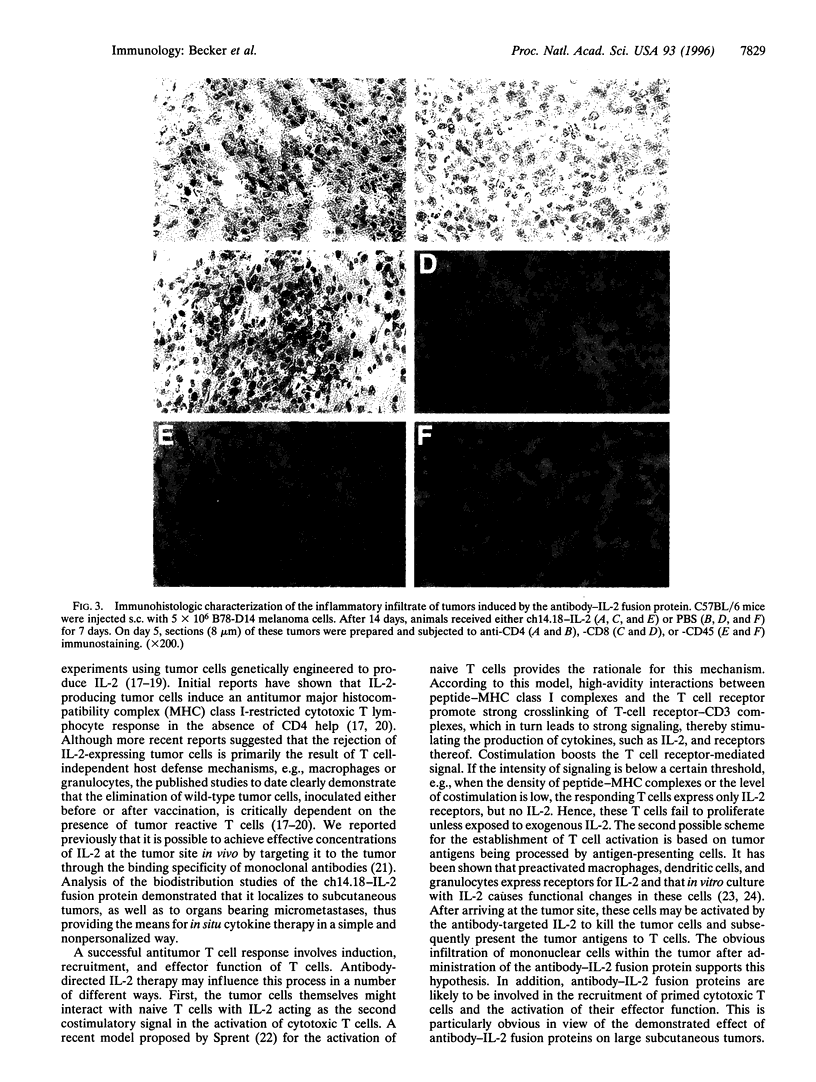
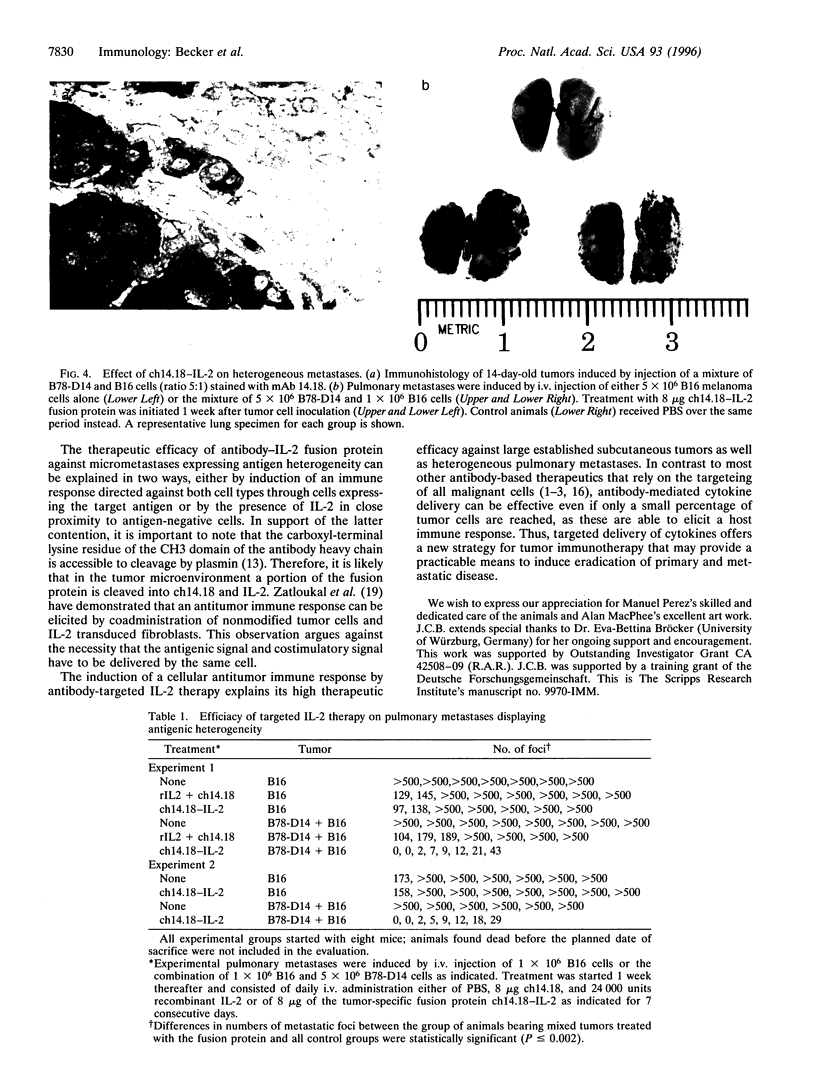
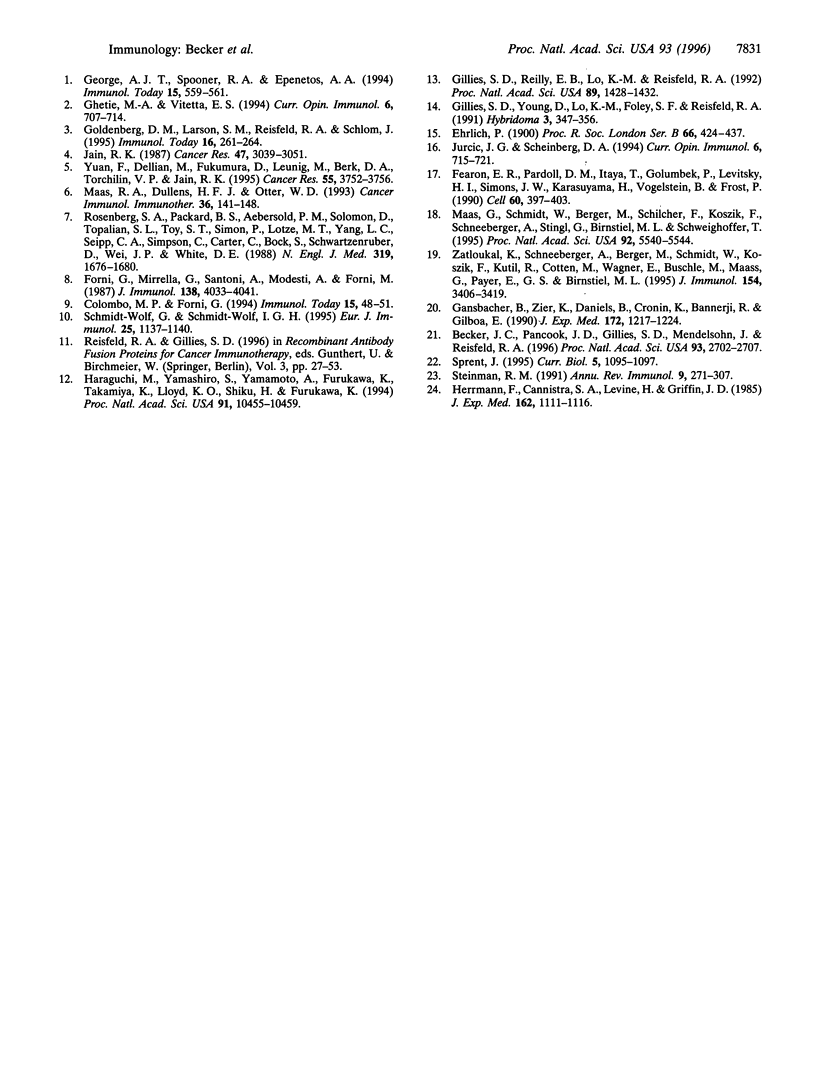
Images in this article
Selected References
These references are in PubMed. This may not be the complete list of references from this article.
- Becker J. C., Pancook J. D., Gillies S. D., Mendelsohn J., Reisfeld R. A. Eradication of human hepatic and pulmonary melanoma metastases in SCID mice by antibody-interleukin 2 fusion proteins. Proc Natl Acad Sci U S A. 1996 Apr 2;93(7):2702–2707. doi: 10.1073/pnas.93.7.2702. [DOI] [PMC free article] [PubMed] [Google Scholar]
- Colombo M. P., Forni G. Cytokine gene transfer in tumor inhibition and tumor therapy: where are we now? Immunol Today. 1994 Feb;15(2):48–51. doi: 10.1016/0167-5699(94)90131-7. [DOI] [PubMed] [Google Scholar]
- Fearon E. R., Pardoll D. M., Itaya T., Golumbek P., Levitsky H. I., Simons J. W., Karasuyama H., Vogelstein B., Frost P. Interleukin-2 production by tumor cells bypasses T helper function in the generation of an antitumor response. Cell. 1990 Feb 9;60(3):397–403. doi: 10.1016/0092-8674(90)90591-2. [DOI] [PubMed] [Google Scholar]
- Forni G., Giovarelli M., Santoni A., Modesti A., Forni M. Interleukin 2 activated tumor inhibition in vivo depends on the systemic involvement of host immunoreactivity. J Immunol. 1987 Jun 1;138(11):4033–4041. [PubMed] [Google Scholar]
- Gansbacher B., Zier K., Daniels B., Cronin K., Bannerji R., Gilboa E. Interleukin 2 gene transfer into tumor cells abrogates tumorigenicity and induces protective immunity. J Exp Med. 1990 Oct 1;172(4):1217–1224. doi: 10.1084/jem.172.4.1217. [DOI] [PMC free article] [PubMed] [Google Scholar]
- George A. J., Spooner R. A., Epenetos A. A. Applications of monoclonal antibodies in clinical oncology. Immunol Today. 1994 Dec;15(12):559–561. doi: 10.1016/0167-5699(94)90216-X. [DOI] [PubMed] [Google Scholar]
- Ghetie M. A., Vitetta E. S. Recent developments in immunotoxin therapy. Curr Opin Immunol. 1994 Oct;6(5):707–714. doi: 10.1016/0952-7915(94)90073-6. [DOI] [PubMed] [Google Scholar]
- Gillies S. D., Reilly E. B., Lo K. M., Reisfeld R. A. Antibody-targeted interleukin 2 stimulates T-cell killing of autologous tumor cells. Proc Natl Acad Sci U S A. 1992 Feb 15;89(4):1428–1432. doi: 10.1073/pnas.89.4.1428. [DOI] [PMC free article] [PubMed] [Google Scholar]
- Gillies S. D., Young D., Lo K. M., Foley S. F., Reisfeld R. A. Expression of genetically engineered immunoconjugates of lymphotoxin and a chimeric anti-ganglioside GD2 antibody. Hybridoma. 1991 Jun;10(3):347–356. doi: 10.1089/hyb.1991.10.347. [DOI] [PubMed] [Google Scholar]
- Goldenberg D. M., Larson S. M., Reisfeld R. A., Schlom J. Targeting cancer with radiolabeled antibodies. Immunol Today. 1995 Jun;16(6):261–264. doi: 10.1016/0167-5699(95)80177-4. [DOI] [PubMed] [Google Scholar]
- Haraguchi M., Yamashiro S., Yamamoto A., Furukawa K., Takamiya K., Lloyd K. O., Shiku H., Furukawa K. Isolation of GD3 synthase gene by expression cloning of GM3 alpha-2,8-sialyltransferase cDNA using anti-GD2 monoclonal antibody. Proc Natl Acad Sci U S A. 1994 Oct 25;91(22):10455–10459. doi: 10.1073/pnas.91.22.10455. [DOI] [PMC free article] [PubMed] [Google Scholar]
- Herrmann F., Cannistra S. A., Levine H., Griffin J. D. Expression of interleukin 2 receptors and binding of interleukin 2 by gamma interferon-induced human leukemic and normal monocytic cells. J Exp Med. 1985 Sep 1;162(3):1111–1116. doi: 10.1084/jem.162.3.1111. [DOI] [PMC free article] [PubMed] [Google Scholar]
- Jain R. K. Transport of molecules in the tumor interstitium: a review. Cancer Res. 1987 Jun 15;47(12):3039–3051. [PubMed] [Google Scholar]
- Jurcic J. G., Scheinberg D. A. Recent developments in the radioimmunotherapy of cancer. Curr Opin Immunol. 1994 Oct;6(5):715–721. doi: 10.1016/0952-7915(94)90074-4. [DOI] [PubMed] [Google Scholar]
- Maas R. A., Dullens H. F., Den Otter W. Interleukin-2 in cancer treatment: disappointing or (still) promising? A review. Cancer Immunol Immunother. 1993;36(3):141–148. doi: 10.1007/BF01741084. [DOI] [PMC free article] [PubMed] [Google Scholar]
- Maass G., Schmidt W., Berger M., Schilcher F., Koszik F., Schneeberger A., Stingl G., Birnstiel M. L., Schweighoffer T. Priming of tumor-specific T cells in the draining lymph nodes after immunization with interleukin 2-secreting tumor cells: three consecutive stages may be required for successful tumor vaccination. Proc Natl Acad Sci U S A. 1995 Jun 6;92(12):5540–5544. doi: 10.1073/pnas.92.12.5540. [DOI] [PMC free article] [PubMed] [Google Scholar]
- Reisfeld R. A., Gillies S. D. Recombinant antibody fusion proteins for cancer immunotherapy. Curr Top Microbiol Immunol. 1996;213(Pt 3):27–53. doi: 10.1007/978-3-642-80071-9_3. [DOI] [PubMed] [Google Scholar]
- Rosenberg S. A., Packard B. S., Aebersold P. M., Solomon D., Topalian S. L., Toy S. T., Simon P., Lotze M. T., Yang J. C., Seipp C. A. Use of tumor-infiltrating lymphocytes and interleukin-2 in the immunotherapy of patients with metastatic melanoma. A preliminary report. N Engl J Med. 1988 Dec 22;319(25):1676–1680. doi: 10.1056/NEJM198812223192527. [DOI] [PubMed] [Google Scholar]
- Schmidt-Wolf G., Schmidt-Wolf I. G. Cytokines and clinical gene therapy. Eur J Immunol. 1995 Apr;25(4):1137–1140. doi: 10.1002/eji.1830250445. [DOI] [PubMed] [Google Scholar]
- Sprent J. Antigen-presenting cells. Professionals and amateurs. Curr Biol. 1995 Oct 1;5(10):1095–1097. doi: 10.1016/s0960-9822(95)00219-3. [DOI] [PubMed] [Google Scholar]
- Steinman R. M. The dendritic cell system and its role in immunogenicity. Annu Rev Immunol. 1991;9:271–296. doi: 10.1146/annurev.iy.09.040191.001415. [DOI] [PubMed] [Google Scholar]
- Yuan F., Dellian M., Fukumura D., Leunig M., Berk D. A., Torchilin V. P., Jain R. K. Vascular permeability in a human tumor xenograft: molecular size dependence and cutoff size. Cancer Res. 1995 Sep 1;55(17):3752–3756. [PubMed] [Google Scholar]
- Zatloukal K., Schneeberger A., Berger M., Schmidt W., Koszik F., Kutil R., Cotten M., Wagner E., Buschle M., Maass G. Elicitation of a systemic and protective anti-melanoma immune response by an IL-2-based vaccine. Assessment of critical cellular and molecular parameters. J Immunol. 1995 Apr 1;154(7):3406–3419. [PubMed] [Google Scholar]





